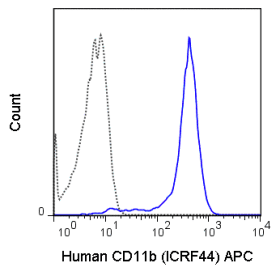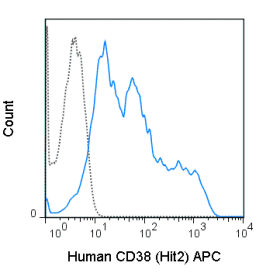The A7R34 antibody is specific for mouse CD127, a 60-90 kDa cell surface protein also known as the Interleukin-7 Receptor alpha chain, or IL-7R alpha. CD127 is typically expressed at the cell surface as a heterodimer with the common gamma chain (CD132). This complex acts as the functional receptor for IL-7, a cytokine important in T and B cell development, and in mature T cell homeostasis. A second cytokine known as Thymic Stromal Lymphopoietin (TSLP) also binds to a receptor complex of CD127 and the TSLPR chain to trigger activation of dendritic cells, and is involved in B cell development, allergy and autoimmunity.
The A7R34 antibody may be used as a phenotypic marker for CD127 on immature B cells, on subsets of thymocytes which are double negative (CD4-CD8- ) or single positive (CD4+ or CD8+), and at low levels on mature, peripheral T cells. CD127 is a key marker, when used in combination with CD4 and CD25, to distinguish Treg and effector/memory Treg populations known as T(REM).
Product Details
| Name | PE-Cyanine7 Anti-Mouse CD127 (IL-7Ra) (A7R34) |
|---|---|
| Cat. No. | 60-1271 |
| Alternative Names | Interleukin-7 Receptor alpha, IL-7Ra |
| Gene ID | 16172 |
| Clone | A7R34 |
| Isotype | Rat IgG2a, κ |
| Reactivity | Mouse |
| Cross Reactivity | |
| Format | PE-Cyanine7 |
| Application | Flow Cytometry |
| Citations* | Uzodinma U. Uche, Ann R. Piccirillo, Shunsuke Kataoka, Stephanie J. Grebinoski, Louise M. D’Cruz, and Lawrence P. Kane. PIK3IP1/TrIP restricts activation of T cells through inhibition of PI3K/Akt. J Exp Med. 2018 Dec 3;215(12):3165-3179. doi: 10.1084/jem.20172018
Avery L, Filderman J, Szymczak-Workman AL, Kane LP4. Tim-3 co-stimulation promotes short-lived effector T cells, restricts memory precursors, and is dispensable for T cell exhaustion. Proc Natl Acad Sci U S A. 2018 Mar 6;115(10):2455-2460. doi: 10.1073/pnas.1712107115 Thaventhiran JED, Hoffmann A, Magiera L, de la Roche M, Lingel H, Brunner-Weinzierl M, and Fearon DT. 2012. Proc. Natl. Acad. Sci. 10.1073. (Flow cytometry). Jin J, Goldschneider I, and Lai L. 2011. J. Immunol. 186: 1915-1922. (in vivo activation) Vondenhoff MF, Greuter M, Goverse G, Elewaut D, Dewint P, Ware CF, Hoorweg K, Kraal G, and Mebius RE. 2009. J. Immunol. 182(9): 5439-5445. (Immunofluorescence microscopy – frozen tissue) Leithauser F, Meinhardt-Krajina T, Fink K, Wotschke B, Moller P and Reimann J. 2006. Am. J. Pathol. 168(6): 1898-1909. (Immunohistochemistry – frozen tissue) Seddon B and Zamoyska R. 2002. J. Immunol. 169: 2997-3005. (in vivo activation) Sudo T, Nishikawa S, Ohno N, Akiyama N, Tamakoshi M, Yoshida H and Nishikawa S-I. 1993. Proc. Natl. Acad. Sci. 90: 9125-9129. (in vitro and in vivo blocking; Immunoprecipitation) |
Application Key:FC = Flow Cytometry; FA = Functional Assays; ELISA = Enzyme-Linked Immunosorbent Assay; ICC = Immunocytochemistry; IF = Immunofluorescence Microscopy; IHC = Immunohistochemistry; IHC-F = Immunohistochemistry, Frozen Tissue; IHC-P = Immunohistochemistry, Paraffin-Embedded Tissue; IP = Immunoprecipitation; WB = Western Blot; EM = Electron Microscopy
*Tonbo Biosciences tests all antibodies by flow cytometry. Citations are provided as a resource for additional applications that have not been validated by Tonbo Biosciences. Please choose the appropriate format for each application and consult the Materials and Methods section for additional details about the use of any product in these publications.










